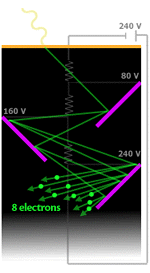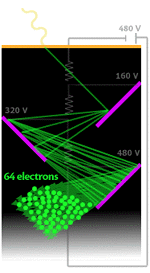
|
The photomultiplier tube at the right has a supply voltage which is twice as large as the supply to the tube to the left, and the potential between each dynode is therefore twice as large as well. But the total number of electrons after the third dynode is not twice as large; in fact, it's eighttimes as large!
Since the voltage is doubled at each stage, eachincident electron produces twice as many secondary electrons. So after one dynode the totalnumber of electrons is doubled. But after two dynodes, there are four times as many total electrons, and after three there are eight times as many. Doubling the supply voltage doubles the number of secondary electrons per incident electron at each dynode, but the cumulative effect after three dynodes is to increase the gain by a factor of eight.
|

|
| What happens when there are more dynodes? | ||